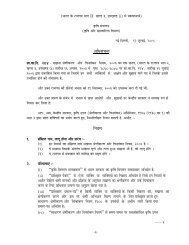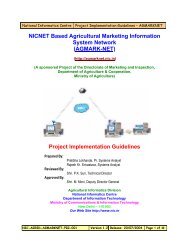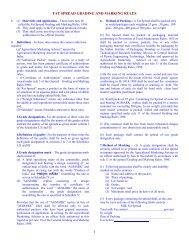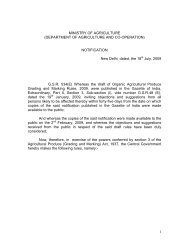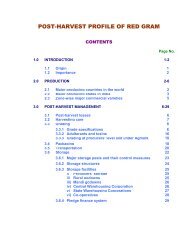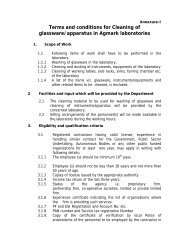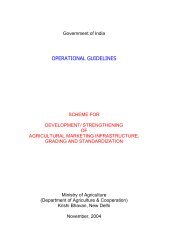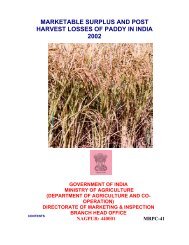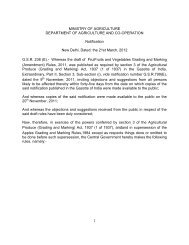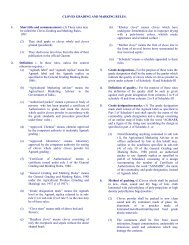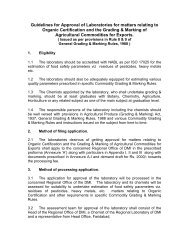Post Harvest Profile of Wheat - Agmarknet
Post Harvest Profile of Wheat - Agmarknet
Post Harvest Profile of Wheat - Agmarknet
Create successful ePaper yourself
Turn your PDF publications into a flip-book with our unique Google optimized e-Paper software.
As per Directorate <strong>of</strong> Marketing and Inspection recent survey, the estimated total postharvest<br />
losses at producer’s level has been 1.79 per cent (unpublished).<br />
Loss <strong>of</strong> 7 million tonnes @ 10 per cent <strong>of</strong> wheat production is colossal, which country can<br />
ill afford. In terms <strong>of</strong> the value, this works out to Rs.35 million by conservative estimates @ Rs.5<br />
per kg. However, following measures should be followed to minimize the post-harvest losses;<br />
� Immediate drying <strong>of</strong> wet grain after harvest.<br />
� Uniform drying to avoid hot and wet spots.<br />
� Use <strong>of</strong> proper techniques <strong>of</strong> processing to avoid losses in threshing<br />
and winnowing by mechanical methods.<br />
� Proper sanitation during drying and storing to avoid contamination <strong>of</strong><br />
grains and protection from insects, rodents and birds.<br />
� Use <strong>of</strong> efficient and good packaging for storage and transportation.<br />
� Use <strong>of</strong> proper scientific techniques in storage for maintaining optimum<br />
moisture content.<br />
� Use <strong>of</strong> pest control measures (fumigation) prior and during storage.<br />
� Providing aeration to stored grains and stir grain bulk occasionally.<br />
� Moving stocks in sacks to discourage pest incidence and its<br />
multiplication.<br />
� Proper handling <strong>of</strong> wheat with suitable transportation facilities helps in<br />
reduction in losses at farm and market level.<br />
3.2 <strong>Harvest</strong>ing Care :<br />
�<br />
�<br />
�<br />
�<br />
�<br />
�<br />
�<br />
�<br />
The time <strong>of</strong> harvesting plays a vital role. The following harvesting care should be taken.<br />
<strong>Wheat</strong> crop should be harvested, when the grains become hard.<br />
<strong>Harvest</strong>ing before maturity means low recovery <strong>of</strong> grain, higher<br />
proportion <strong>of</strong> immature seeds, broken and poor quality and disease<br />
prone during storage.<br />
Delay in harvesting means shattering and spillage <strong>of</strong> grains. Its<br />
exposure to birds, rodents and insect and pest attack.<br />
<strong>Harvest</strong>ing should be done in dry summer season.<br />
<strong>Harvest</strong>ing should be done by using proper method and improved<br />
equipments.<br />
<strong>Harvest</strong>ed wheat should be kept separately to avoid mixing <strong>of</strong> varieties.<br />
Direct sun drying and excessive drying should be avoided.<br />
Threshing and winnowing should be done in the fields. The grains<br />
should be packed in sound clean gunny bags to minimize the losses<br />
during transportation.<br />
6




